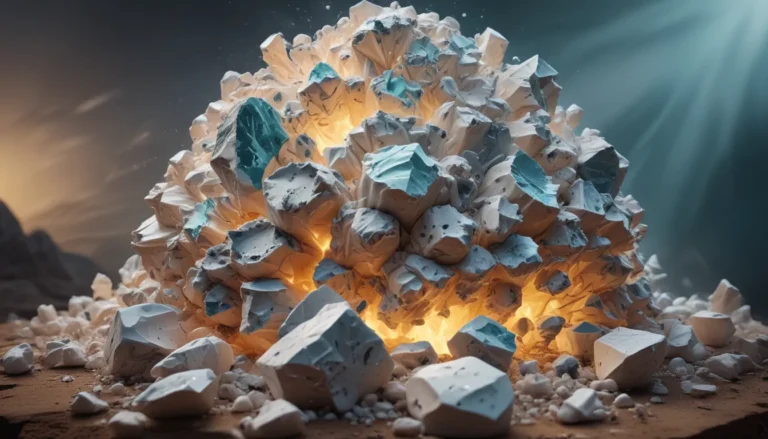A Note About Images: The images used in our articles are for illustration purposes only and may not exactly match the content. They are meant to engage readers, but the text should be relied upon for accurate information.
Are you fascinated by the mysteries of chemical bonding and molecular structures? Do you want to explore the intriguing world of orbital hybridization and its impact on various scientific disciplines? If so, you’ve come to the right place! In this comprehensive guide, we will delve into the realm of orbital hybridization, unraveling its significance in understanding the properties of organic and inorganic compounds. From its historical origins to its applications in drug design and material science, we will uncover 20 fascinating facts about orbital hybridization that will broaden your knowledge and pique your curiosity.
The Evolution of Orbital Hybridization
Let’s embark on a journey back in time to the genesis of orbital hybridization. The concept of orbital hybridization was first proposed by the eminent chemist Linus Pauling in the 1930s. Pauling developed this theory to elucidate the molecular geometry of compounds, paving the way for a deeper understanding of chemical bonding.
Demystifying Atomic Orbitals
Before we delve into the intricacies of orbital hybridization, it’s essential to grasp the concept of atomic orbitals. Atomic orbitals are regions around an atom’s nucleus where electrons are likely to be found. When these atomic orbitals combine through hybridization, new hybrid orbitals with unique shapes and properties are formed, influencing the bonding and geometry of molecules.
Unraveling the Types of Orbital Hybridization
Orbital hybridization encompasses three primary types: sp, sp2, and sp3. These hybrid orbitals arise from the fusion of s and p orbitals in different combinations, giving rise to a diverse array of molecular structures and geometries.
Understanding the Role of Hybridization in Bonding
Orbital hybridization plays a pivotal role in determining the type of chemical bonding in molecules. It elucidates the formation of single, double, and triple bonds, shedding light on the mechanism behind the stability and reactivity of compounds.
Exploring sp Hybridization in Linear Molecules
In linear molecules such as carbon monoxide (CO) and hydrogen cyanide (HCN), sp hybridization occurs when one s and one p orbital merge to form two sp hybrid orbitals aligned in a linear configuration.
Delving into sp2 Hybridization in Trigonal Planar Molecules
The realm of trigonal planar molecules like boron trifluoride (BF3) and ethylene (C2H4) revolves around sp2 hybridization, where one s and two p orbitals amalgamate to create three sp2 hybrid orbitals arranged in a trigonal planar geometry.
Embracing sp3 Hybridization in Tetrahedral Molecules
The enchanting world of tetrahedral molecules, exemplified by methane (CH4) and ammonia (NH3), showcases the magic of sp3 hybridization. One s and three p orbitals intertwine to give rise to four sp3 hybrid orbitals arranged in a tetrahedral configuration.
Illuminating the Significance of Hybridization in Organic Chemistry
Orbital hybridization serves as a cornerstone in organic chemistry, offering profound insights into the shapes and properties of organic molecules. It unveils the mysteries behind the stability and reactivity of organic compounds, enriching our understanding of this intricate realm.
Navigating the Influence of Dipoles in Hybridization
The interplay of orbital hybridization with molecular dipole moments shapes the polar or nonpolar nature of molecules. The arrangement of hybrid orbitals dictates the distribution of electrons, sculpting the overall polarity of compounds.
Embarking on the Journey of sp3d Hybridization in Trigonal Bipyramidal Molecules
Enter the captivating realm of trigonal bipyramidal molecules like phosphorus pentachloride (PCl5) and sulfur hexafluoride (SF6), where the central atom undergoes sp3d hybridization, resulting in five hybrid orbitals arranged in a trigonal bipyramidal geometry.
Unveiling the Enigma of sp3d2 Hybridization
Witness the beauty of octahedral molecules such as sulfur hexafluoride (SF6) through the lens of sp3d2 hybridization. The central atom manifests six hybrid orbitals, culminating in an octahedral arrangement that captivates the imagination.
Admiring the Role of Hybridization in Resonance
Orbital hybridization serves as a guiding light in unraveling the enigmatic phenomenon of resonance in molecules. It facilitates the delocalization of electrons and the stabilization of molecular structures, enriching our comprehension of chemical bonding.
Harnessing the Power of Hybridization in Drug Design
The realm of drug design is intricately intertwined with the understanding of orbital hybridization. By leveraging insights into molecular geometry and bond properties, scientists can craft more potent and targeted drugs, revolutionizing the landscape of pharmacology.
Embracing Hybrid Orbitals in Organic Reaction Mechanisms
Hybrid orbitals are the unsung heroes in organic reaction mechanisms, orchestrating the ballet of bonding and geometry changes during chemical reactions. Their pivotal role in the formation of new compounds underpins the elegance of organic chemistry.
Unveiling the Importance of Hybridization in Material Science
Material science owes a debt of gratitude to orbital hybridization, as it underpins the electronic and structural properties of materials. By manipulating properties like conductivity, strength, and magnetic behavior, scientists can engineer materials with tailored characteristics.
Decoding the Influence of Hybridization on Molecular Shape
The exquisite dance of orbital hybridization intricately shapes the geometry of molecules, dictating whether they manifest as linear, bent, trigonal planar, or tetrahedral structures. The fusion of hybrid orbitals orchestrates the symphony of molecular configurations.
Embracing Hybrid Orbitals and Molecular Bond Angles
The formation of hybrid orbitals exerts a profound influence on the bond angles within molecules. Each hybridization type bequeaths specific bond angles, such as 180° in linear molecules and 109.5° in tetrahedral molecules, crafting a kaleidoscope of geometrical possibilities.
Contemplating the Limitations of Hybridization Theory
While orbital hybridization offers a powerful toolkit for deciphering molecular structures, it does harbor certain limitations. In complex molecular geometries and bond angles, this theory may fall short in providing a comprehensive explanation.
Unraveling the Nexus Between Hybridization and Molecular Orbitals
The hybrid orbitals engendered through orbital hybridization can further amalgamate to form molecular orbitals. These molecular orbitals infuse the molecule with its electronic structure and properties, offering a holistic perspective on its behavior.
Envisioning Experimental Evidence Supporting Hybridization
Various experimental techniques, including X-ray crystallography, spectroscopy, and electron diffraction, bolster the credibility of orbital hybridization. These methodologies furnish direct evidence of the hybridization of atomic orbitals, cementing its status as a foundational concept in chemistry.
Conclusion: A Glimpse Into the Enigmatic World of Orbital Hybridization
In conclusion, orbital hybridization stands as a bedrock of modern chemistry, unraveling the intricacies of molecular structures and bonding arrangements. The diverse tapestry of hybrid orbitals – sp, sp², sp³, and sp³d – imbues molecules with their unique geometries, shaping their properties and reactivity. Delving into the realm of orbital hybridization equips us with the tools to predict chemical behaviors and unlock the mysteries of organic and inorganic substances.
FAQs: Navigating the Intricacies of Orbital Hybridization
-
What is orbital hybridization?
Orbital hybridization involves the fusion of atomic orbitals to create new hybrid orbitals with distinct properties, elucidating molecular geometries and bonding patterns in chemical compounds. -
How does orbital hybridization influence molecular shape?
The type of hybrid orbitals utilized determines the molecular shape, with sp hybridization yielding linear geometries, sp² fostering trigonal planar shapes, and sp³ engendering tetrahedral geometries. -
What are the applications of orbital hybridization?
Orbital hybridization finds diverse applications in predicting chemical properties, such as bond angles, bond lengths, and molecular polarity, essential in drug design, material science, and environmental studies. -
Can orbital hybridization be observed experimentally?
While direct observation of orbital hybridization is challenging, its effects on molecular geometries, bond angles, and lengths can be inferred through techniques like X-ray crystallography and spectroscopy. -
Are all atoms capable of hybridization?
Not all atoms have the capacity for hybridization, with carbon, nitrogen, and oxygen being prime examples of central atoms adept at forming multiple bonds. -
How does hybridization impact the reactivity of molecules?
Hybridization influences the stability and reactivity of molecules by dictating electron density arrangements and the availability of unhybridized orbitals for bonding and chemical interactions. -
Can orbital hybridization manifest in transition metal complexes?
Yes, orbital hybridization can occur in transition metal complexes, with d and s orbitals combining to form hybrid orbitals, generating complex geometries and unique bonding phenomena. -
What is the relationship between orbital hybridization and molecular orbital theory?
Orbital hybridization and molecular orbital theory both involve the amalgamation of atomic orbitals, with the former focusing on localized bonding in specific atoms, while the latter considers the delocalized nature of electrons across entire molecules. -
Can hybrid orbitals overlap with atomic orbitals?
Yes, hybrid orbitals can overlap with atomic orbitals to forge sigma and pi bonds in covalent bonding, influencing the strength and stability of chemical bonds. -
Is orbital hybridization confined to carbon compounds?
While carbon compounds exemplify diverse forms of hybridization, other elements such as nitrogen, oxygen, and sulfur can also undergo orbital hybridization, yielding unique bonding arrangements in their compounds.
Delve into the enchanting world of orbital hybridization to unravel the mysteries of chemical bonding and molecular structures. Witness the transformative power of hybrid orbitals as they shape the landscape of chemistry and unlock the secrets of the molecular realm. Experience the thrill of discovery as you navigate the wondrous world of orbital hybridization and deepen your understanding of the mesmerizing complexities of chemical phenomena.






